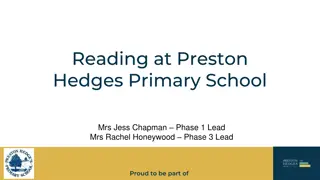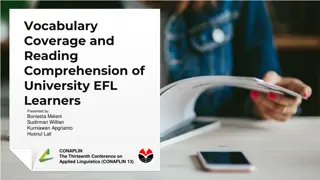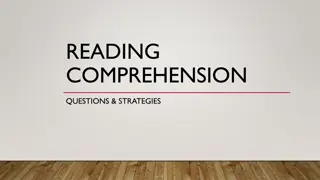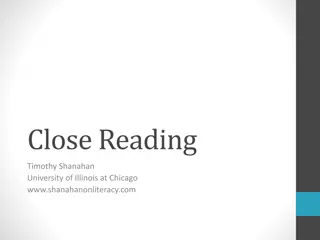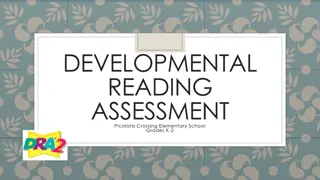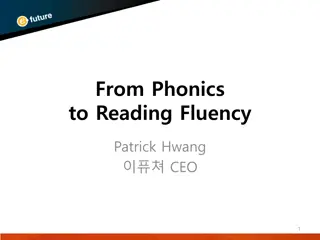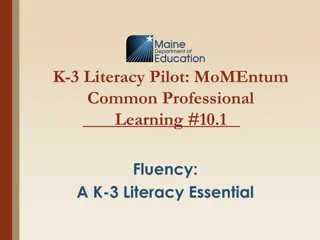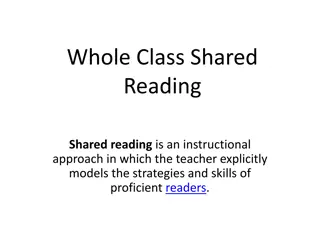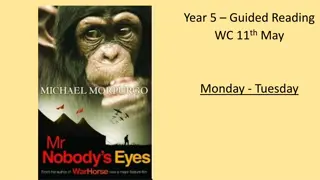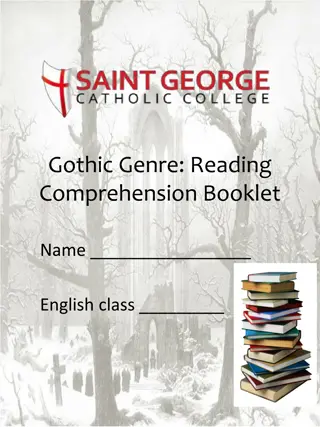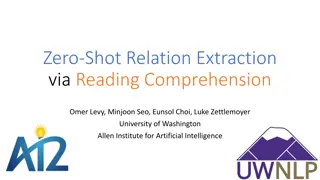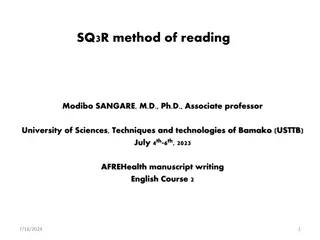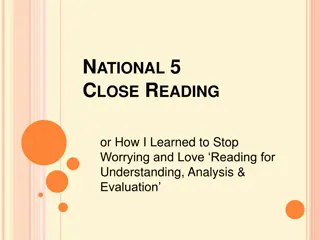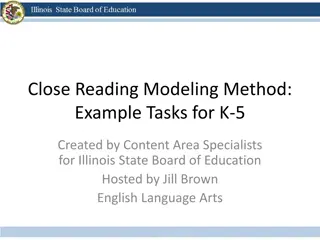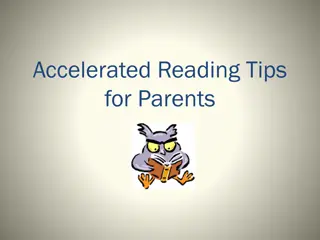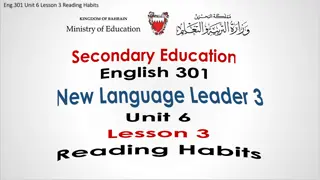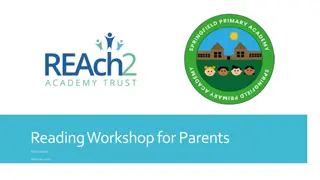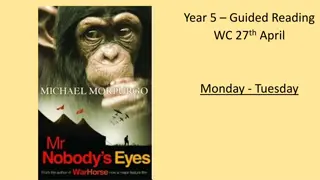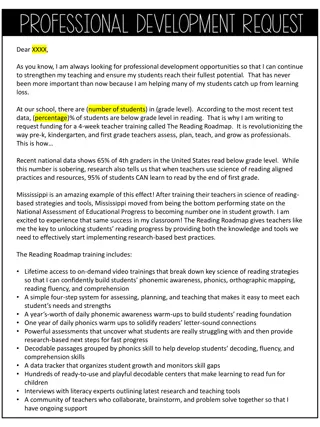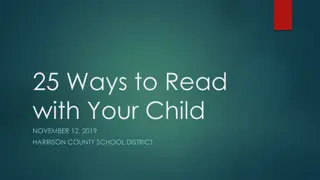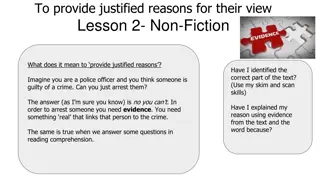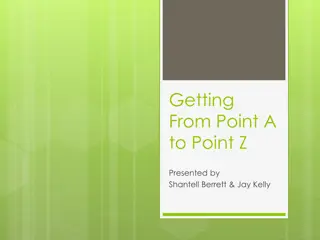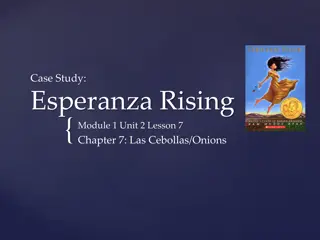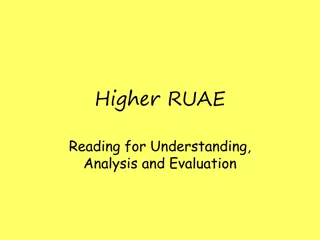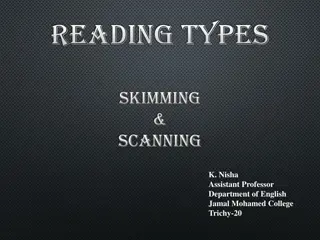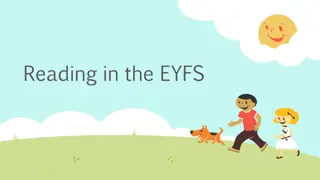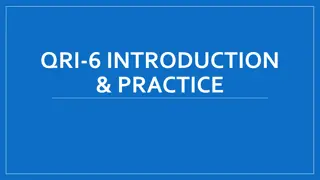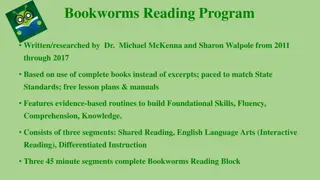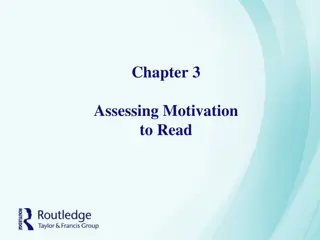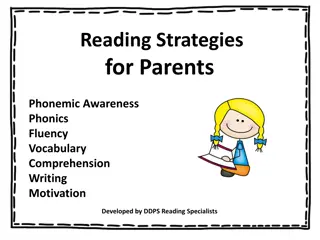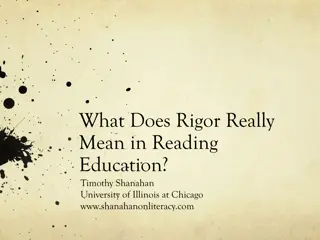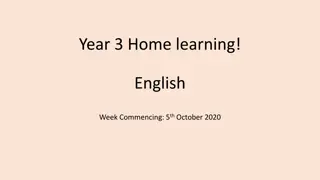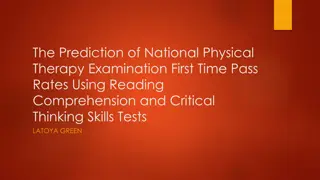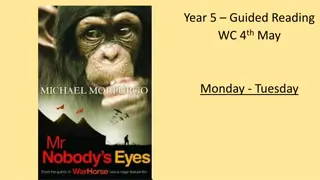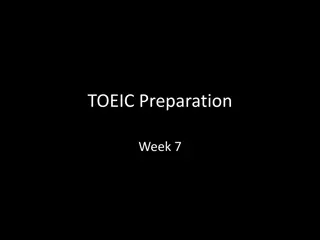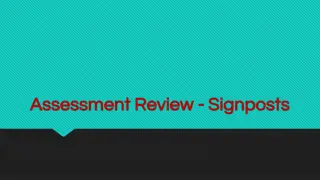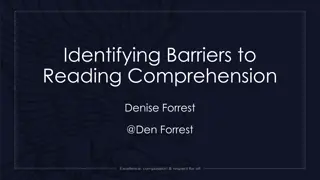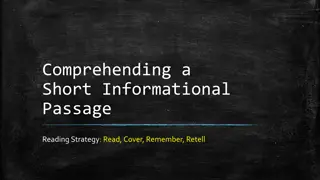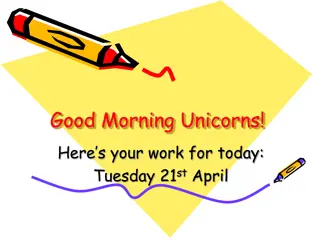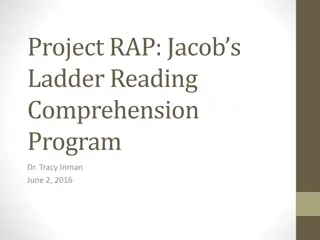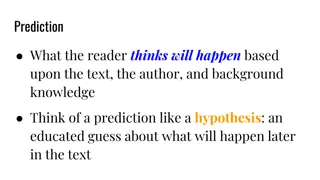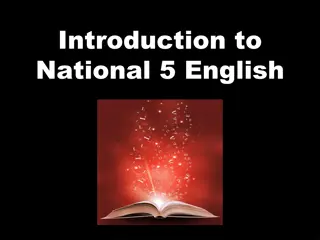Close Reading Techniques for Better Comprehension
Learn how to effectively tackle close reading passages by mastering two types of questions: factual questions and context questions. Explore examples and steps to improve your understanding and interpretation skills. Enhance your ability to extract key information, translate it into your own words, and analyze the context to grasp the meaning of unfamiliar words.
Download Presentation

Please find below an Image/Link to download the presentation.
The content on the website is provided AS IS for your information and personal use only. It may not be sold, licensed, or shared on other websites without obtaining consent from the author. Download presentation by click this link. If you encounter any issues during the download, it is possible that the publisher has removed the file from their server.
E N D
Presentation Transcript
Close Reading Understanding Questions Check your understanding (!) of the passage Come in 2 basic types: Factual, or own words questions (the most common type) Context questions
Close Reading Factual Questions Two steps to success: Highlight, circle or underline the information that will answer the question 2) Translate this information into your own words in such a way that it answers the question you have been asked. Key words from the passage must be changed: you get nothing for lifting words from the passage. 1)
Close Reading Example: I m nocturnal. I love the moonlight, the shadows, the dark places, the dappled murk. I m not being poetic. I m simply being true to my nature, my nocturnal nature. Like all tarantulas. Question: In your own words, in what way is the speaker like all tarantulas ? (1 mark)
Close Reading Example: I m nocturnal. I love the moonlight, the shadows, the dark places, the dappled murk. I m not being poetic. I m simply being true to my nature, my nocturnal nature. Like all tarantulas. Question: In your own words, in what way is the speaker like all tarantulas ? (1 mark)
Close Reading Example: I m nocturnal. I love the moonlight, the shadows, the dark places, the dappled murk. I m not being poetic. I m simply being true to my nature, my nocturnal nature. Like all tarantulas. Question: In your own words, in what way is the speaker like all tarantulas ? (1 mark) Answer: The speaker is active by night.
Close Reading Understanding questions 2: CONTEXT QUESTIONS These ask you how the context of a word helps you to understand its meaning. There are two stages to answering these questions: Write down what you think the word means (take an intelligent guess if necessary!) 1. 2. Show how the context helps you understand it by quoting words or phrases which give you clues.
Close Reading Example: I m nocturnal. I love the moonlight, the shadows, the dark places, the dappled murk. I m not being poetic. I m simply being true to my nature, my nocturnal nature. Like all tarantulas. Question: Show how the context helps you understand the meaning of nocturnal .
Close Reading I m nocturnal. I love the moonlight, the shadows, the dark places, the dappled murk. I m not being poetic. I m simply being true to my nature, my nocturnal nature. Like all tarantulas. Suggested Answer: Nocturnal means being active at night. The writer refers to his preference for moonlight and dark which both suggest night-time.
Link Questions These questions ask you to show how a sentence acts as a link in the writer s argument or chain of thought
Link Questions There are 2 main steps to answering a link question: First, quote the part of the sentence which refers back to the writer s previous topic, and explain what this topic is Second, quote the part of the sentence which refers forwards to the next topic, and explain what this topic is
Link Questions For instance: William Shakespeare is easily the best-known of our English writers. Virtually every man in the street can name some of his plays and his characters, and many people can also recite lines of his poetry by heart. However, despite our familiarity with his work, we know relatively little of the man himself. We do not know when or why he became an actor, we know nothing of his life in London, and almost nothing of his personal concerns. Question: Show how the third sentence acts as a link in the argument. 2 marks
Link Questions For instance: William Shakespeare is easily the best-known of our English writers. Virtually every man in the street can name some of his plays and his characters, and many people can also recite lines of his poetry by heart. However, despite our familiarity with his work, we know relatively little of the man himself. We do not know when or why he became an actor, we know nothing of his life in London, and almost nothing of his personal concerns.
Link Questions For instance: William Shakespeare is easily the best-known of our English writers. Virtually every man in the street can name some of his plays and his characters, and many people can also recite lines of his poetry by heart. However, despite our familiarity with his work, we know relatively little of the man himself. We do not know when or why he became an actor, we know nothing of his life in London, and almost nothing of his personal concerns.
Link Questions Answer: The phrase "our familiarity with his work" looks back at the topic of how widely known Shakespeare's work is. The second part of the sentence, "we know relatively little of the man himself , introduces the new topic, namely the things that are not known about Shakespeare, and a list of these follows this "link" sentence.
Close reading Question type 2: Analysis ANALYSIS means looking at the writer s style: word-choice imagery Sentence structure: Sentence type/length Use of punctuation Word order formal/informal style tone (or mood)
Close Reading Analysis questions may: Ask you about specific techniques, (e.g. comment on the writer s word choice in lines 14-15; Comment on the sentence structure in paragraph 3 etc.), Or may simply ask you to comment on the techniques used by the writer, in which case it is up to you to identify and comment on the writer s techniques.
Close Reading Analysis questions 1: Word Choice Word choice questions ask you to comment on the shades of meaning (connotations) of individual words. You need to be able to explain why the connotations of a particular word are appropriate, i.e. why has the writer chosen this particular word at this point. A good way of approaching this is to think of a more neutral word the writer could have used, and to think about what difference this would make to their meaning.
Close Reading Task: Write down as many synonyms for these words as you can think of: Walk Speak
Close Reading Example Question Mr Smith trudged up the corridor towards his 4thyear class, who were eagerly awaiting their close reading lesson. Question: What does the writer s word choice tell us about the teacher s attitude to his class? (2)
Close Reading Example Question Mr Smith trudged up the corridor towards his 4thyear class, who were eagerly awaiting their close reading lesson. Question: What does the writer s word choice tell us about the teacher s attitude to his class? (2)
Close Reading Example Question Mr Smith trudged up the corridor towards his 4thyear class, who were eagerly awaiting their close reading lesson. Question: What does the writer s word choice tell us about the teacher s attitude to his class? (2) Possible answer: The word trudged has connotations of slow, heavy movement, and it shows us that Mr Smith was unhappy or lacking in enthusiasm for his class.
Close Reading Analysis Questions 2: Imagery Mostly concerned with three figures of speech Simile Metaphor Personification
Imagery Simile Signified by the use of like or as as. e.g. The messenger ran like the wind The poppies were as red as blood Easy to recognise trickier to explain
Imagery The messenger ran like the wind It is not enough to say the messenger ran very fast because this just gives you the meaning (denotation) when you will be asked about its effect A better beginning would be: The simile (quote it) gives the impression of speed because the wind is fast But this will still not explain why the writer specifically chose wind so
Imagery an even better answer The simile (quote it) gives the impression of speed because the wind is seen as a powerful force which reaches great speeds. It might also suggest that the runner was so fast that he was creating turbulence like the wind. N.B. you need to explain denotation plus connotation
Why is this simile effective? the poppies were as red as blood Answer (This simile is effective) because it tries to communicate the intensity of the red colour of the poppies. The word blood suggests not just colour, but the richness of the flower s tone.
Why use a metaphor? The metaphor is the most powerful form of imagery Metaphor says one thing is something else Good metaphors contain a lot of information that can be transferred economically to the reader Think about the connotations of this metaphor and what it conveys to you about the umbrellas: As the wind strengthened the men clung on to the big, black birds of their umbrellas. Few words but lots of ideas.
So . . . To work with a metaphor you need to: 1. Identify the metaphor but you get no marks for that on its own. 2. Show how the connotations of the metaphor help to develop or refine your idea of what is being described 3. Show the link between the connotations which you have chosen and the literal meanings of the words used in the metaphor (2 and 3 can be reversed)
Example 1 Too many tourists are so wedded to their camera that they cease to respond directly to the places of beauty they visit. They are content to take home a dozen rolls of exposed film instead, like a bank full of monopoly money. Show how the metaphor highlights the writer s disapproval of the tourists
So how do we apply this formula? The metaphor is wedded (0 marks) 2. The connotationsof wedded are being in a permanent relationship as a result of being married, dependency, closeness, exclusivity 3. All of which have the effect of illustrating how completely indispensable and consuming the camera is to the tourist as if they are married. Answer: The metaphor wedded suggests that just as a married couple are in a close, long-lasting relationship in which they depend on each other, so the tourists are completely dependent on their cameras, as though they could not imagine life without them 1.
Personification Personification is a sub-set of metaphor Some thing or an animal is given human attributes Analyse it in the same way as a metaphor Consider the sky wept
Imagery - Summary Identify or quote the image (simile, metaphor or personification) 1. Show how the literal and figurative (denotation and connotation) come together to create an effect e.g. Just as so 2. 3. Say what the effect is why is the writer using it in this way?
ANALYSING IMAGERY For each example, write down: Identify the technique/image Analyse the connotations/meaning of the image Link the image to the writer s intended meaning ie. The writer uses this metaphor to show that in the same way that a hurricane is unstoppable and violent, the boxer is described as aggressive and overwhelming.
EXAMPLE 1 I mourn for kids who will never know the delight of cycling with the wind in their hair, or climbing up trees or exploring hidden places. Growing up devoid of freedom, decision-making, and the opportunity to learn from taking their own risks, our children are becoming trapped, neurotic and as generally weakened as battery hens. How effective do you find the image of battery hens in conveying the writer s view of the way children are currently being brought up?
EXAMPLE 1 ANSWER The writer uses this simile to suggest that just as battery hens are reared in a restrictive and controlled environment, considered cruel and unhealthy, so young people are also lacking in freedom to explore and enjoy their surroundings, with similar consequences for their health and happiness.
EXAMPLE 2 She was particularly shocked by one headline A DOOR WE CAN T CLOSE. She said, It makes me feel like vermin. Show how the language of these lines shows how strongly she felt.
EXAMPLE 2 ANSWER She appears to feel very strongly about this headline because the simile of vermin suggests that she feels low, despised by everyone, just as if she was a dirty, disease-carrying rat which people avoid.
EXAMPLE 3 The UK is not a group of nations swamped by a tidal wave of immigration. Relatively speaking, Europe contends with a trickle of refugees compared with countries who border areas of famine, desperate poverty or violent political upheaval. What is the impact of the imagery in these lines in making clear the writer s point?
EXAMPLE 3 The UK is not a group of nations swamped by a tidal wave of immigration. Relatively speaking, Europe contends with a trickle of refugees compared with countries who border areas of famine, desperate poverty or violent political upheaval. What is the impact of the imagery in these lines in making clear the writer s point?
EXAMPLE 4 Whether the specific storms that scythed down trees in Paris last Christmas, drowned Po valley last month and battered Britain last week can be attributed to the warming trend is a subject of serious and contentious scientific debate. Show how the writer uses imagery to emphasise the impact of the storms which affected Europe. You should refer to two examples in your answer.
EXAMPLE 5 And in August this year, a tremor of apprehension ran through the scientific community when the Russian ice- breaker Yamal, on a tourist cruise of the Arctic, muscled its way through the unusually thin ice to the North Pole to find itself sailing serenely into an astonishing blue sea. What impression are you given of the progress of the Yamal by the imagery of these lines?
EXAMPLE 6 The rain batters the glass roof of the conservatory, competing with the loud music blaring from the sound system inside. Show how the imagery conveys the strength of the rain.
EXAMPLE 7 Comment on each of these images: The shop was a goldmine for its owners. An army of football supporters arrived in town. His remark in class was met with stony silence. The actor gave a very wooden performance.
EXAMPLE 8 (SYMBOLISM) But, the bat broke. Some kid used it without permission. He hit a foul ball and the bat split, the barrel flying away, the splintered handle still in the kid s hands. When the bat broke, it seemed a certain spell was broken too. I drifted away from baseball by steps and bounds. The next summer, 1967, Ali was convicted of dodging conscription. Baseball did not seem very important. Show how the bat is an important symbol for the writer.
Analysis 3 - Sentence Structure The structure of a sentence means the way in which it is made up, and how the various elements are arranged. To answer questions on sentence structure, you need to: A) Identify and describe the significant feature(s)of sentence structure B) Comment on their effect.
Sentence Structure LITTLE PEOPLE WILL TRIUMPH PERHAPS
Sentence Structure Little - Length of sentences People - Punctuation Will - Word order Triumph - Type of sentence Perhaps - Person (1st, 2nd, 3rd)
Step One: Little - Length of sentences Consider whether sentences are long and complex or short and simple Long sentences often use lists to suggest the variety and complexity of their subject matter, and they may build up to a climax (or anti-climax) Short sentences are more typical of spoken language and can be used to create a sense of shock, pace, tension, or simply to reflect a more colloquial (spoken, informal)tone.


